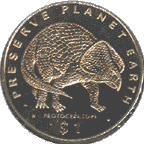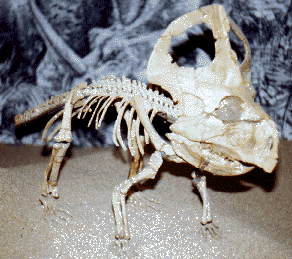
Protoceratops
andrewsi -Granger et Gregory, 1923- skeleton of mature specimen
Archosauria: Ornithischia:
Ceratopsia: Protoceratopsidae
Locality: Tugrikin Us, Gobi
Desert, southern Mongolia
Age: Late Cretaceous (Campanian), 75 million years
ago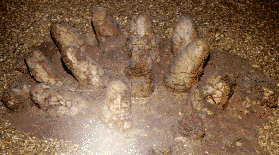
Nest
of protoceratops eggs
Archosauria: Ornithischia: Ceratopsia: Protoceratopsidae
Locality:
Bain Dzak, Gobi Desert, southern Mongolia
Age: Late
Cretaceous (Campanian), 75 million years ago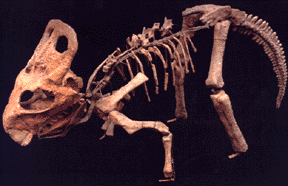
Protoceratops
andrewsi -Granger et Gregory, 1923- skeleton of immature specimen
Archosauria:
Ornithischia: Ceratopsia: Protoceratopsidae
Locality: Tugrikin
Us, Gobi Desert, southern Mongolia
Age: Late Cretaceous (Campanian), 75 million
years ago
Protoceratops
andrewsi is one of the best known dinosaurs.
Hundreds of skeletons have been collected
in Mongolia.
Sometimes these skeletons make up more than 80% of all dinosaurs
from a site.
All stages of growth are present
from unhatched eggs containing
embryos to hatchlings to juveniles to
adults. Because so many stages of growth
of this dinosaur are known,
scientists have been able to understand how the skeleton
changed throughout the
life of the individual. This is very unusual to know about
fossil animals.
The young of many living land vertebrates have a larger head relative
to the
body than is seen in adults. Comparison between the two skeletons of
Protoceratops
andrewsi, the hatchling and the adult, shows this same pattern.
Protoceratops
seems to have lived in large herds, possibly forming nesting
colonies along the
shores of ancient lakes and streams that lay in an otherwise arid
landscape. The
disaters which can occur in such an environment, such as drought
or flash flooding
combined with the natural tendency of these dinosaurs to
gather, probably led
to the unusual abundance of them in the fossil record.
Protoceratops andrewsi
is a neoceratopsian-a group of dinosaurs which
typically have horns. There were
none on this species- only low bony knobs of bone on
the skull. The descendants
of Protoceratops andrewsi probably emigrated from Asia to
North America where
they eventually led to such well-known dinosaurs as
Triceratops. The expansion
of bone at the back of the
skull, or the 'frill' as it is generally known, acted
to reorient the muscles that
moved the lower jaw so they functioned more efficiently.
The frill may also have played a
role similar to horns in deer and elk where they
act to establish social dominance between
individuals of a group and to help animals
within a species recognize another of their
species especially during breeding
times. The eggs and skeleton of Protoceratops
andrewsi illustrate the various
stages of life that these animals went through.
As with many vertebrates as they
grow, the proportions of the skeleton
of the juvenile are different from those
of the adult.
Both the protoceratopsids and ceratopsids were robust quadrupeds.
The
protoceratopsids were small- or medium-sized forms, whereas the largest ceratopsids
reached
up to 8 meters in length and looked somewhat similar to modern rhinoceri.
The
protoceratopsids are known from Central Asia and West of North America.
This group
gave rise to ceratopsids that were more evolutionarily advanced and known
only
from the West of North America. 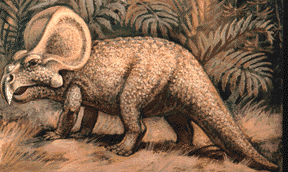
One
of the main difference between protoceratopsids and ceratopsids is their skull structure.
In both these groups the rear part of the skull roof forms a large bony "frill",
while the ceratopsians also possessed variously developed horns on the nasal bones
and above the orbits as well as along the edge of the frill.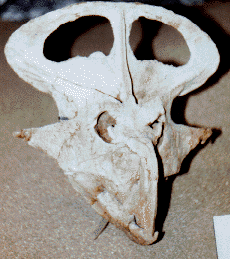
Protoceratops
andrewsi -Granger et Gregory, 1923- skull
Archosauria: Ornithischia: Ceratopsia:
Protoceratopsidae
Locality: Tugrikin Us, Gobi Desert, southern
Mongolia
Age: Late Cretaceous (Campanian), 75 million years ago

